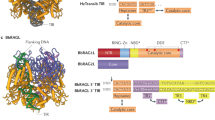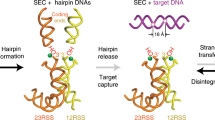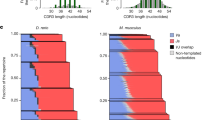Abstract
Immunoglobulin and T-cell-receptor genes are assembled from component gene segments in developing lymphocytes by a site-specific recombination reaction, V (D)J recombination. The proteins encoded by the recombination-activating genes, RAG1 and RAG2, are essential in this reaction, mediating sequence-specific DNA recognition of well-defined recombination signals and DNA cleavage next to these signals. Here we show that RAG1 and RAG2 together form a transposase capable of excising a piece of DNA containing recombination signals from a donor site and inserting it into a target DNA molecule. The products formed contain a short duplication of target DNA immediately flanking the transposed fragment, a structure like that created by retroviral integration and all known transposition reactions. The results support the theory that RAG1 and RAG2 were once components of a transposable element, and that the split nature of immunoglobulin and T-cell-receptor genes derives from germline insertion of this element into an ancestral receptor gene soon after the evolutionary divergence of jawed and jawless vertebrates.
This is a preview of subscription content, access via your institution
Access options
Subscribe to this journal
Receive 51 print issues and online access
$199.00 per year
only $3.90 per issue
Buy this article
- Purchase on Springer Link
- Instant access to full article PDF
Prices may be subject to local taxes which are calculated during checkout







Similar content being viewed by others
References
Tonegawa, S. Somatic generation of antibody diversity. Nature 302 , 575–581 (1983).
Lewis, S. M. The mechanism of V(D)J joining: lessons from molecular, immunological, and comparative analyses. Adv. Immunol. 56, 27–150 (1994).
Schatz, D. G., Oettinger, M. A. & Baltimore, D. The V(D)J recombination activating gene (RAG-1). Cell 59, 1035–1048 ( 1989).
Oettinger, M. A., Schatz, D. G., Gorka, C. & Baltimore, D. RAG-1 and RAG-2, adjacent genes that synergistically activate V(D)J recombination. Science 248, 1517–1523 ( 1990).
McBlane, J. F.et al. Cleavage at a V(D)J recombination signal requires only RAG1 and RAG2 proteins and occurs in two steps. Cell 83, 387–395 (1995).
Eastman, Q. M., Leu, T. M. J. & Schatz, D. G. Initiation of V(D)J recombination in vitro obeying the 12/23 rule. Nature 380, 85– 88 (1996).
van Gent, D. C., Ramsden, D. A. & Gellert, M. The RAG1 and RAG2 proteins establish the 12/23 rule in V(D)J recombination. Cell 85, 107– 113 (1996).
Sawchuk, D. J.et al. V(D)J recombination: modulation of RAG1 and RAG2 cleavage activity on 12/23 substrates by whole cell extract and DNA bending proteins. J. Exp. Med. 185, 2025–2032 (1997).
van Gent, D. C., Hiom, K., Paull, T. T. & Gellert, M. Stimulation of V(D)J cleavage by high mobility group proteins. EMBO J. 16, 2665–2670 (1997).
van Gent, D. C., Mizuuchi, K. & Gellert, M. Similarities between initiation of V(D)J recombination and retroviral integration. Science 271, 1592–1594 (1996).
Weaver, D. T. What to do at an end—DNA double-strand-break repair. Trends Genet. 11, 388–392 ( 1995).
Chu, G. Double strand break repair. J. Biol. Chem. 272, 24097–24100 (1997).
Grawunderr, U., West, R. B. & Lieber, M. R. Antigen receptor gene rearrangement. Curr. Opin. Immunol. 10, 172–180 (1998).
Thompson, C. B. New insights into V(D)J recombination and its role in the evolution of the immune system. Immunity 3, 531– 539 (1995).
Lewis, S. M. & Wu, G. E. The origins of V(D)J recombination. Cell 88, 159–162 (1997)
Litman, G. W.et al. Phylogenetic diversification of immunoglobulin genes and the antibody repertoire. Mol. Biol. Evol. 10, 60–72 (1993).
Gellert, M. Recent advances in understanding V(D)J recombination. Adv. Immunol. 64, 39–64 ( 1996).
Craig, N. L. Unity in transposition reactions. Science 270, 253–254 (1995).
Agrawal, A. & Schatz, D. G. RAG1 and RAG2 form a stable post-cleavage synaptic complex with DNA containing signal ends in V(D)J recombination. Cell 89, 43–53 ( 1997).
Mizuuchi, K. Transpositional recombination: mechanistic insights from studies of Mu and other elements. Annu. Rev. Biochem. 61, 1011–1051 (1992).
Melek, M., Gellert, M. & van gent, D. C. Rejoining of DNA by the RAG1 and RAG2 proteins. Science 280, 301–303 ( 1998).
Spanopoulou, E.et al . The homeodomain of Rag-1 reveals the parallel mechanisms of bacterial and V(D)J recombination. Cell 87, 263–276 (1996).
Weinert, T. A., Derbyshire, K. M., Hughson, F. M. & Grindley, N. D. F. Replicative and conservative transpositional recombination of insertion sequences. Cold Spring Harb. Symp. Quant. Biol. 49, 251–260 (1984).
Benjamin, H. W. & Kleckner, N. Intramolecular transposition by Tn10. Cell 59, 373– 383 (1989).
Isberg, R. R. & Syvanen, M. Tn5 transposes independently of cointegrate resolution. Evidence for an alternative model for transposition. J. Mol. Biol. 182, 69– 78 (1985).
Shoemaker, C., Hoffmann, J., Goff, S. P. & Baltimore, D. Intramolecular integration within Moloney Murine Leukemia Virus DNA. J. Virol. 40, 164–172 ( 1981).
Lee, Y. M. H. & Coffin, J. M. Efficient autointegration of avian retrovirus DNA in vitro. J. Virol. 64, 5958 –5965 (1990).
Fujiware, T. & Mizuuchi, K. Retroviral DNA integration: structure of an integration intermediate. Cell 54, 497–504 (1988).
Brown, P. O., Bowerman, B., Varmus, H. E. & Bishop, J. M. Retroviral integration: structure of the initial covalent product and its precursor, and a role for the viral IN protein. Proc. Natl Acad. Sci. USA 86, 2525–2529 ( 1989).
Berg, D. E. & Howe, M. M. Mobile DNA(Am. Soc. Microbiol., Washington DC, (1989)).
Mizuuchi, K. Polynucleotidyl transfer reactions in transpositional DNA recombination. J. Biol. Chem. 267, 21273–21276 (1992).
Kleckner, N., Chalmers, R. M., Kwon, D., Sakai, J. & Bolland, S. Tn10 and IS10 transposition and chromosome rearrangements: mechanism and regulation in vivo and in vitro. Curr. Top. Microbiol. Immunol. 204, 49–82 (1996).
Hiom, K. & Gellert, M. Assembly of a 12/23 paired signal complex: a critical control point in V(D)J recombination. Mol. Cell 1, 1011–1019 ( 1998).
Dyda, F.et al. Crystal structure of the catalytic domain of HIV-1 integrase: similarity to other polynucleotidyl transferases. Science 266, 1981–1986 (1994).
Rice, P., & Mizuuchi, K. Structure of the bacteriophage Mu transposase core: a common structural motif for DNA transposition and retroviral integration. Cell 82, 209– 220 (1995).
Bujacz, G.et al. High-resolution structure of the catalytic domain of avian sarcoma virus integrase. J. Mol. Biol. 253, 333– 346 (1995).
Chalmers, R., Guhathakurta, A., Benjamin, H. & Kleckner, N. IHF modulation of Tn10 transposition: sensory transduction of supercoiling status via a proposed protein/DNA molecular spring. Cell 93, 897–908 (1998).
Craig, N. L. Target site selection in transposition. Annu.. Rev. Biochem. 66, 437–474 (1997).
Sakai, J. & Kleckner, N. The Tn10 synaptic complex can capture a target DNA only after transposon excision. Cell 89 , 205–214 (1997).
Rast, J. P.et al. α, β, γ and δ T cell antigen receptor genes arose early in vertebrate phylogeny. Immunity 6, 1–11 (1997).
Sakano, H., Hüppi, K., Heinrich, G. & Tonegawa, S. Sequences at the somatic recombination sites of immunoglobulin light-chain genes. Nature 280, 288– 294 (1979).
Zwilling, S., König, H. & Wirth, T. High mobility group protein 2 functionally interacts with the POU domains of octamer transcription factors. EMBO J. 14, 1198–1208 ( 1995).
Lewis, S. M. & Hesse, J. E. Cutting and closing without recombination in V(D)J joining. EMBO J. 10, 3631– 3639 (1991).
Hsieh, C., McCloskey, R. P., Radany, E. & Lieber, M. R. V(D)J recombination: evidence that a replicative mechanism is not required. Mol. Cell. Biol. 11, 3972– 3977 (1991).
Acknowledgements
We thank D. Hesslein for GST-RAG protein; I. Villey for HMG2 and RAG proteins; C.-L. Tsai for RAG proteins; P. Shockett for help with denaturing polyacrylamide gels; W. Stephen for bacterial plates and media; F. Livak for pTetRSS; E. Spanopoulou for the GST–RAG plasmids; T. Wirth for the HMG2 plasmid; J. Repasky and E. Corbett for help with various procedures; N. Craig and G. Litman for comments on the manuscript; and the W. M. Keck Foundation Biotechnology Resource Laboratory at Yale University for oligonucleotides and DNA sequencing. D.G.S. is an associate investigator of the Howard Hughes Medical Institute. This work was supported by a grant from the NIH.
Author information
Authors and Affiliations
Corresponding author
Rights and permissions
About this article
Cite this article
Agrawal, A., Eastman, Q. & Schatz, D. Transposition mediated by RAG1 and RAG2 and its implications for the evolution of the immune system. Nature 394, 744–751 (1998). https://doi.org/10.1038/29457
Received:
Accepted:
Issue Date:
DOI: https://doi.org/10.1038/29457
This article is cited by
-
A systematic screen for co-option of transposable elements across the fungal kingdom
Mobile DNA (2024)
-
Genomic view of the origins of cell-mediated immunity
Immunogenetics (2023)
-
Structural insights into the evolution of the RAG recombinase
Nature Reviews Immunology (2022)
-
On the relationship between extant innate immune receptors and the evolutionary origins of jawed vertebrate adaptive immunity
Immunogenetics (2022)
-
TCR-pMHC: may the force be of you?
Cellular & Molecular Immunology (2021)
Comments
By submitting a comment you agree to abide by our Terms and Community Guidelines. If you find something abusive or that does not comply with our terms or guidelines please flag it as inappropriate.



